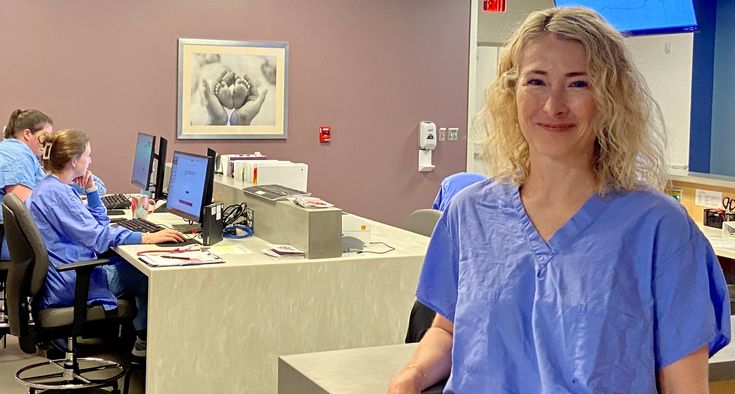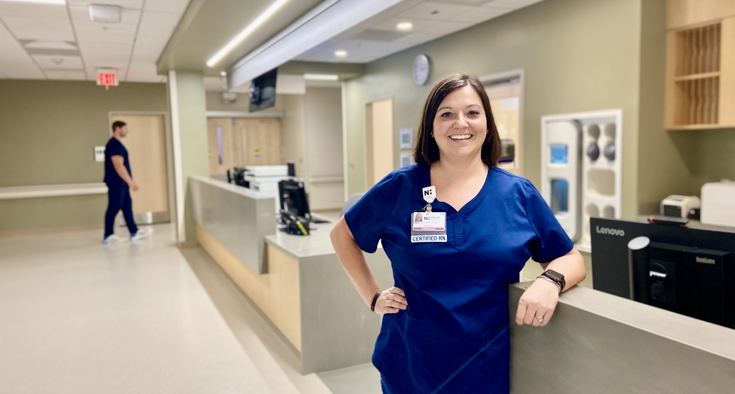Laborists are doctors who deliver babies.
You’re probably thinking: Isn’t that the same thing as an OB/GYN?
It is. The difference is that laborists don’t typically see patients in a doctor’s office. They work almost exclusively in a hospital setting — just delivering babies and managing other OB/GYN emergencies.
Dr. Shannon Zona recently returned to the Triad from Kansas City, Missouri, to join Novant Health Kernersville Medical Center as a laborist at the hospital’s new maternity program that launched in March.
Exceptional care for you and your growing family.
Before moving to the Midwest, the former Dr. Shannon Mattern delivered hundreds of babies in her nearly 20 years in private practice in High Point. The mom of two sons – a 15-year-old and a 17-year-old headed to UNC Chapel Hill this fall – remarried in July. She has a new husband, new name and, as of early May, a new job.
When Zona’s children were entering junior high and high school a few years ago, she had begun to feel private practice wasn’t ideal for her family life. “I wanted more established hours and to actually be able to make it to some of my kids’ events,” she said. At that time, the laborist model had not expanded to the smaller community hospitals in the Piedmont Triad.

“That’s what led me to Kansas City. I grew up in the Midwest, and we have season tickets to University of Missouri football and the Kansas City Current women’s soccer games. I Googled ‘OB hospitalist Kansas City,’ which sounds completely nuts. But I found an opening for a laborist in a suburban community hospital just beginning to employ this model.”
Before that, Zona had always been a traditional OB/GYN who divided her time between clinic and a hospital. But focusing on delivering babies and managing patients in the hospital greatly appealed to her. When she’s at the hospital full-time, she can be completely engaged and present for patients.
Historically, OB triage nurses assess a patient’s condition and then contact the OB on call. In the laborist model, no one’s waiting for the on-call OB to arrive. He or she is already at the hospital and able to provide more immediate care.
The laborist model benefits the OB/GYN, the rest of the labor and delivery team and, most importantly, the patient. Some women become close with their OB/GYNs and are understandably disappointed to learn their OB won’t deliver their baby. In truth, however, women often don’t have their baby delivered by their OB/GYN because he or she is not on call when the moment arrives.
More focused, less distracted
The laborist birthing model is not new. It emerged in the 1990s but became more widely utilized in major metropolitan areas of the United States about 15 to 20 years ago and is now being introduced in smaller regions. Zona is Kernersville’s first laborist. Other Novant Health hospitals that have laborists include Novant Health Forsyth Medical Center, Novant Health Mint Hill Medical Center and Novant Health Ballantyne Medical Center.
It’s easy to see why this is a birthing model that’s growing in popularity. “A laborist can be at the bedside and is able to focus primarily on patients in the hospital without having to balance that with a busy office schedule,” Zona said.
While a laborist doesn’t often meet patients until they’re in the hospital, that’s not all that different from the standard model. “Many women go to a multiprovider group and rotate around during their pregnancy to meet different providers,” Zona said. “But there’s no guarantee that their doctor – or any doctor they’ve met – will deliver their baby.”
A happy homecoming
Zona is thrilled to return to the region where she spent most of her career. She’ll have better working hours than she had in Missouri. She’ll be working 24-hour shifts, which she called “very doable.”
Her role in Kansas City was focused more on triaging and managing obstetrical emergencies but less on routine deliveries. After a while, she realized how much she missed being a part of those experiences. When Dr. Lewis Lipscomb, a classmate from residency and leader at Novant Health, suggested she apply for the opportunity in Kernersville, the timing was serendipitous.
When she came to interview, she liked everybody she met. And everything she saw in the sparkling new maternity unit.
“That beautiful, brand-new unit certainly makes a good impression on patients,” she said. “While walking through the unit, it struck me how thoughtfully designed it was. The group in charge of designing the unit actually built a prototype labor and delivery room in a warehouse. The staff brought in medical equipment and played around with it to determine the best layout.”
Zona – who’s lived in California, Missouri and Minnesota in addition to North Carolina – has worked in hospitals with architect-designed, state-of-the-art exam and treatment rooms that were gorgeous. But they were not always functional. “When you have an emergency, the most important things are to have easy access to the equipment you need and space to work without restriction,” she said. “The unit in Kernersville provides just that.”
So, seeing how much consideration the clinical staff put into designing beautiful – and utilitarian – spaces – impressed Zona. “They’ve been that careful in hiring providers who’ll work well together – who have a good bedside manner and really care about patients,” she said. “All of that made me want to be a part of this place.”
Esta doctora habla español
No additional training is required for an OB/GYN to become a laborist because they’ve already been trained. And Zona has delivered hundreds of babies in her career.
She also speaks Spanish – that headline translates to “This doctor speaks Spanish” – which she said allows her to relate to more patients.
“Caring for Spanish-speaking patients is some of the most rewarding work I do,” she said. In Kansas City, she had a patient who didn’t speak any English and had an ectopic pregnancy – a dangerous condition in which the fertilized egg grows outside the uterus.
No one else in the emergency department that night spoke Spanish. And this patient needed emergency surgery. Zona calmed the woman’s fears and explained everything that was happening.










